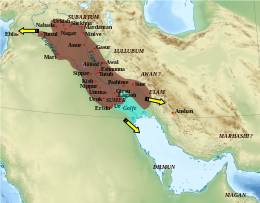
Back Akkad Afrikaans Akkad ALS አካድ Amharic أكد (مدينة) Arabic اكاد ARZ Akkad (şəhər) Azerbaijani Аккаде Bashkir Акадэ Byelorussian Акад (град) Bulgarian Akad BS

Akkad (/ˈækæd/; also spelt Accad, Akkade, a-ka₃-de₂ki or Agade, Akkadian: 𒀀𒂵𒉈𒆠 akkadê, also 𒌵𒆠 URIKI in Sumerian during the Ur III period) was the capital of the Akkadian Empire, which was the dominant political force in Mesopotamia during a period of about 150 years in the last third of the 3rd millennium BC.
Its location is unknown. In the early days of research various unidentified mounds were considered as the location of Akkad.[1] In modern times most of the attention has focused on an area roughly defined by 1) near Eshnunna, 2) near Sippar, 3) not far from Kish and Babylon, 4) near the Tigris River, and 5) not far from the Diyala River - all within roughly 30 kilometers of modern Baghdad in central Iraq. There are also location proposals as far afield as the Mosul area in northern Iraq.[2][3][4]
The main goddess of Akkad was Ishtar-Annunitum or ‘Aštar-annunîtum (Warlike Ishtar),[5] though it may have been a different aspect, Istar-Ulmašītum.[6] Her husband Ilaba was also revered. Ishtar and Ilaba were later worshipped at Girsu and possibly Sippar in the Old Babylonian period.[2]
The city is possibly mentioned in the Hebrew Bible (Genesis 10:10) where it is written אַכַּד (ʾAkkaḏ, classically transliterated Accad), in a list of the cities of Nimrod in Sumer (Shinar).
In the early days of Assyriology, it was suggested that the name of Agade is not of Akkadian language origin. Proposals include Sumerian language, Hurrian language or the Lullubian (though that is unattested). The non-Akkadian origin of the city's name would suggest that the site may have been occupied in pre-Sargonic times.[7]
- ^ Unger, Eckhard (1928), "Akkad", in Ebeling, Erich; Meissner, Bruno (eds.), Reallexikon der Assyriologie (in German), vol. 1, Berlin: W. de Gruyter, p. 62, OCLC 23582617
- ^ a b Westenholz, C. F., "The Old Akkadian Period: History and Culture", in Mesopotamien: Akkade-Zeit und Ur III-Zeit (Orbis Biblicus et Orientalis 160/3), Universitätsverlag Freiburg Schweiz, Freiburg, Schweiz, pp. 11-110, 1999
- ^ Cite error: The named reference
Wall-Romanawas invoked but never defined (see the help page). - ^ Cite error: The named reference
Weisswas invoked but never defined (see the help page). - ^ Meador, Betty De Shong (2001), Inanna, Lady of the Largest Heart. Poems by the Sumerian High Priestess Enheduanna, Austin: University of Texas Press, ISBN 978-0-292-75242-9
- ^ Sharlach, T. M., "Belet-šuhnir and Belet-terraban and Religious Activities of the Queen and the Concubine(s)", in An Ox of One's Own: Royal Wives and Religion at the Court of the Third Dynasty of Ur, Berlin, Boston: De Gruyter, pp. 261-286, 2017
- ^ Speiser, Ephraim Avigdor, "Elam And Sumer In The Epigraphical Sources", in Mesopotamian Origins: The Basic Population of the Near East, Philadelphia: University of Pennsylvania Press, pp. 26-58, 1930